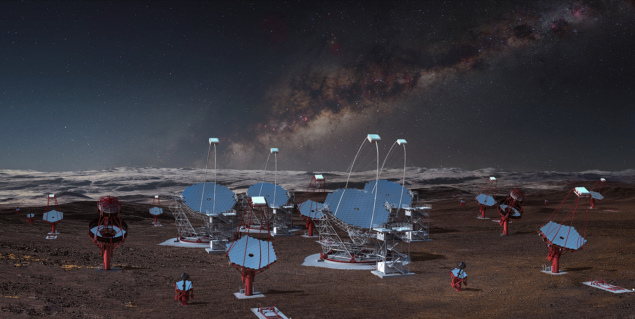
As a subfield of astroparticle physics, gamma-ray astronomy, investigates many questions rooted in particle physics in an astrophysical context. A prominent example is the search for self-annihilating Weakly Interacting Massive Particles (WIMPs) in the Milky Way as a signature of dark matter. Another long-standing problem is finding out where in the universe the cosmic-ray particles detected on Earth are accelerated to PeV energies and beyond.
With the imminent commissioning of the Cherenkov Telescope Array (CTA), which will comprise more than 100 telescopes located in the northern and southern hemispheres, gamma-ray astronomy is about to enter a new era. This was taken as an opportunity to discuss the statistical methods used to analyze data from Cherenkov telescopes at a dedicated PHYSTAT workshop hosted by the university of Berlin. More than 300 participants, including several statisticians, registered for PHYSTAT-Gamma from 28 to 30 September to discuss concrete statistical problems, find synergies between fields, and set the employed methods in a broader context.
Three main topics were addressed at the meeting across 13 talks and multiple discussion sessions: statistical analysis of data from gamma-ray observatories in a multi-wavelength context, connecting statisticians and gamma-ray astronomers, and astrophysical sources across different wavelengths. Many concrete physical questions in gamma-ray astronomy must be answered in an astrophysical context, which becomes visible only by observing the electromagnetic spectrum. A mutual understanding of the statistical methods and systematic errors is therefore needed. Josh Speagle (University of Toronto) proclaimed a potential ‘datapocalypse’ in the heterogeneity and amount of soon-to-be-expected astronomical data. Similarities between analyses in X- and gamma-ray astronomy gave hope for reducing the data heterogeneity. Further cause for optimism arose from new approaches for combining data from different observatories.
The second day of PHYSTAT-Gamma focused on building connections between statisticians and gamma-ray astronomers. Eric Feigelson (Penn State) gave an overview of astrostatistics, followed by deeper discussions of Bayesian methods in astronomy by Tom Loredo (Cornell) and techniques for fitting astrophysical models to data with bootstrap methods by Jogesh Babu (Penn State). The session concluded with an overview of statistical methods for the analysis of astronomical time series by Jeff Scargle (NASA).
The final day centered on the problem of how to match astrophysical sources across different wavelengths. CTA is expected to detect gamma rays from more than 1000 sources. Identifying the correct counterparts at other wavelengths will be essential to study the astrophysical context of the gamma-ray emission. Applying Bayesian methods, Tamas Budavari (Johns Hopkins) discussed the current state of the problem from a statistical point of view, followed by in-depth talks and discussions among experts from X-ray, gamma-ray, and radio astronomy.
Topics across all sessions were the treatment of systematic errors and the formats for exchanging data between experiments. Technical considerations appear to dominate the definition of data formats in astronomy currently. However, for example, as Fisher famously showed with the introduction of sufficiency, statistical aspects can help to find useful representations of data and might also be considered in the definition of future data formats.
PHYSTAT-gamma was only the first attempt to discuss statistical aspects of gamma-ray astronomy. For example, the LHCf experiment at CERN will help to improve the prediction of the gamma-ray flux, which is expected from astrophysical hadron colliders and measured by gamma-ray observatories like CTA. However, modeling uncertainties from particle physics must be treated appropriately to improve the constraints on astrophysical processes. The discussion of this and many further topics is planned for follow-up meetings.







